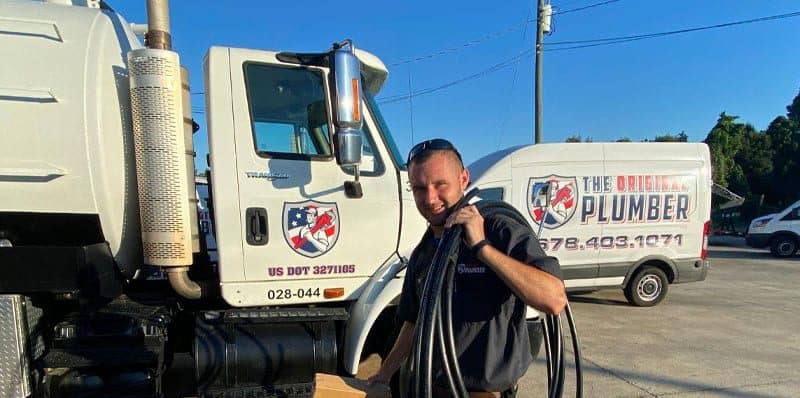Signs That Indicate Septic Tank Leach Field Problems
Unless you’re a trained plumber, it can be difficult to determine whether or not you’re having issues with your septic tank. If you live in a rural area, you may rely on your septic tank to treat and dispose of waste created by your household. Once your household waste leaves your house, it enters a septic tank leach field, also known as a septic drain field. The septic tank leach field is a subsurface facility that’s used to remove impurities from the liquid that emerges after moving through the septic tank. If you are not sure where you septic tank is located.
Luckily, there are some signs that indicate a septic tank leach field or the septic tank itself is failing. Some of these signs include:
- Drains or toilets in your house are backing up – Backups and clogs are typically caused by a septic tank that hasn’t been emptied in a while. However, if your septic tank leach field is failing, the water leaving your home will not be processed and treated at all. When this happens, your drains become backed up.
- Toilets are slow to flush – If all of the toilets in your home are slow to flush, it may mean that your septic tank is filling up with sludge. This sludge isn’t being processed by your drain field as it should be and therefore is causing delays in your toilet flushing.
- Sinks and bathtubs don’t drain as quickly as they used to – If your sinks or bathtubs aren’t draining as quickly as they normally should, your septic drain field could be to blame. When you find yourself waiting a long time for your tub to drain after a bath or your sink to empty after doing dishes, it may be time to call for a septic drain field replacement.
- You find standing water near your drain field or septic tank – Standing water near your drain field or septic tank is the biggest indicator that your septic tank is flooded and that your septic leach field may be failing. Standing water is caused when the water in your septic tank has nowhere to go after being treated and processed.
- You start smelling sewage near your drain field or septic tank – Both your septic tank and septic drain field should be odor-free, both outside and inside your home. The odors you smell are caused by carbon dioxide, methane, and hydrogen sulfide, which are all found in household waste. If you can smell a strong rotten egg odor near your leach field, it may indicate that sewage is leaking. This is a threat to your health and safety, as well as the health of others. This is when you should call immediately for a septic drain field replacement.
Resources:
Signs That Indicate you Need an Immediate Drain Field Replacement
So how do you know if you need a septic drain field replacement and not just a repair? Signs that you need an immediate drain field replacement include:
- Failure to clean or pump waste out of your septic tank regularly – If you’re not sticking to your septic tank cleaning schedule, you’re putting yourself at risk for needing a septic drain field replacement. You should have your septic tank pumped and inspected every three to five years in order to make sure that your drain field will function properly. You may need more frequent septic tank pumping depending on the number of people in your household, whether or not you have a garbage disposal, if you use water softeners, how many guests will be in your home at once, how often you do laundry, or if you have a sewer ejector pump.
- Broken pipes in your drain field – This one is fairly obvious. If your plumber is inspecting the pipes coming to and from your leach field and notices a break in the pipes, you’re getting a septic drain field replacement. Broken septic pipes cannot be patched, so new pipes or a new system may be in order.
- Lack of oxygen in the septic tank due to a large amount of grease – The “scum” layer is caused by an excess amount of grease in your septic tank system can mean your leach field is getting replaced. Once your septic tank is filled with too much grease, the drain holes and piping leading to your drain field will become clogged and in need of replacement.
- Tree roots putting pressure on your drain field piping – When tree roots starting growing into your piping, it could be a recipe for disaster. These tree roots can grow quickly and will seek a source of water as quickly as possible. If the pipes pushing water to your leach field are sufficient, the tree roots will make their way there, potentially rupturing the piping.
- Soil compacting from heavy equipment or cars near your septic tank drain field – Drain fields near air in the soil surrounding them. When heavy equipment or cars are parked or placed on top of or near the leach field, problems can arise. Compacted soil allows for water to pool near your septic field.
Common Septic Tank Problems and How to Fix Them
You probably don’t pay much attention to what happens to your excess water after it goes down the drain until something starts to go wrong. It’s vital that you ensure a proper septic tank repair regularly to avoid costly damage. Before you do anything, you need to first find your septic tank. The way your septic system works is pretty complex and most of it is underground, so problems with it can often go undetected for long periods of time. Not only that, but when you do discover an issue, it can be difficult to pinpoint exactly where the problem is. If you’re noticing septic tank problems, odds are likely that one of these five things is the cause of the problem.
Clogs in Your Septic System
If you’re experiencing septic tank issues, think back to the last time your septic tank was pumped out. Over time, septic tanks fill up with waste and grey water passes through your septic tank to drain lines underground in your yard. If your tank is getting too full, you may start to notice your drains are getting slow or your toilet is becoming backed up. Each source of water in your home runs through your septic system. How fast your tank fills up will depend on how many people live in your home and how much waste water you’re generating on a daily basis.
If your septic tank has been pumped within a year or two, you probably don’t need to have it pumped out again. If that’s the case and you’re still experiencing septic tank problems, you probably have a clog somewhere between your home and your septic tank and will need to determine where it’s located. If your drains are all draining slowly, you likely have a clog in one of the pipes that drain away from your home. These pipes can often become clogged by items that should not have been flushed down your toilet. These pipes range from 4 to 8 inches in diameter, so in some areas, they’re likely narrower than others. This makes it possible for debris to pass through certain sections and get stuck in others.
If your drains are draining well, but you’re noticing that sewage is starting to get backed up into plumbing fixtures in your home or gathering near your septic tank, there’s likely some type of clog in your effluent filter. If this filter looks good, the problem might be in your septic tank’s inlet baffle. If you can access this part of the tank, you should be able to easily tell whether or not there is a clog. You may even be able to remove the clog by pushing it through the access port. If you’re unsure of how to access any of this, be sure to consult with a plumber.
Tree Roots are Infiltrating Your Pipes
Another cause of septic tank issues can be tree roots that are in the way. If sewage is starting to back up into your drains, there are mysterious cracks in your driveway and sidewalk, or you’re noticing constant puddles and wet patches in your lawn when it hasn’t rained, roots may have infiltrated your pipes. Roots can cause your drain pipes to crack, and as they grow over time, these cracks will widen and cause major damage. They may even begin to clog your sewer pipes.
You can prevent root infiltration by installing newer, plastic pipes that are capable of withstanding damage from roots. If you’re thinking of planting new trees, be sure to have your pipes mapped out so that you plant things far enough away from them. It’s also a good idea to treat your pipes with root growth inhibitors if you do have trees close to where your pipes are. If you believe tree roots may have already invaded your pipes, you can perform a septic tank & pipe cleaning or use a solution flushed down your toilet to remove existing roots. If you can stand to part with the trees whose roots are infiltrating your pipes, cut them down and remove the stumps to prevent roots from growing back after you’ve cleaned out your pipes.
Leaks in Sewage Tank or Lines
Many homeowners dream of green luscious grass, but if your grass is vibrantly green while the plants surrounding it are dead, it may be a sign of a leak in your septic tank. Unexplained green grass can also be an indicator that your septic tank is sending too much water through your lateral lines and saturating your yard. In this case, there may even be sewage pooling in your yard. You’ll want to consult with a plumbing professional immediately to ensure this problem is fixed as soon as possible to avoid potential health hazards and costly damage.
Incorrect Septic Tank Installation
Proper septic system placement allows the system to run efficiently. Do you know if the company that installed your septic system did so correctly? If you purchased an older home, you probably don’t know who installed the septic system. And since you can’t see your septic system, you also have no idea what’s going on down there.
Installation mistakes include failure to bury the tank deep enough, installing the wrong-size tank, or using the wrong soil in the drainfield – all of these mistakes can lead to septic tank failure. Regular maintenance helps prevent septic tank backups and allows you to know exactly what’s going on with your septic system.
Increased Water Use
Your septic tank can only hold so much water before it overflows. If a large number of people rely on the septic system, your septic tank may fail. If you have a large family or expect many long-term guests, or you host parties on a regular basis, you should have your tank inspected to make sure it’s the right size. If not, you may need to upgrade to a larger tank.
Your septic system can be pretty hearty, and it should work properly for many years if you maintain it correctly. If you’re noticing any septic tank problems such as signs of clogged pipes, root infiltration, or sewage leaks, take action and contact The Original Plumber & Septic for a septic tank inspection to resolve any issues as quickly as possible.




